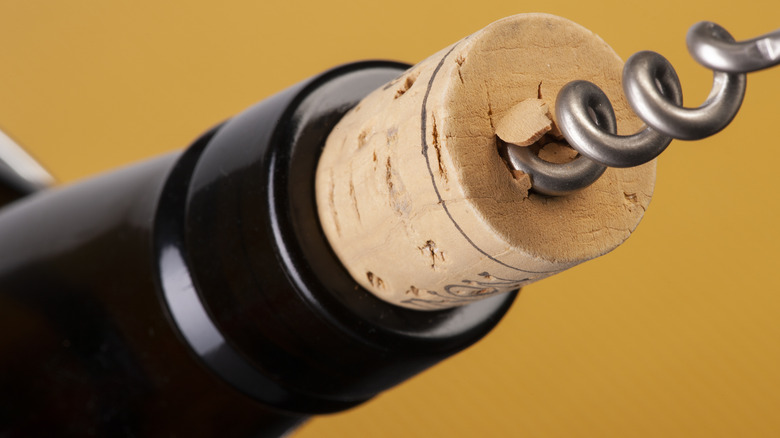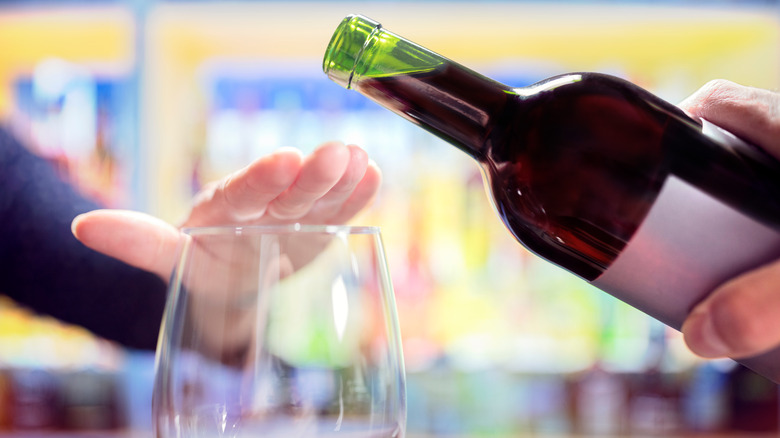What To Do If You Accidentally Purchase A Corked Bottle Of Wine
Let's say you have a special occasion. You've labored long in the kitchen, preparing the perfect meal, and you open that special bottle of wine you splurged on at the wine shop. Instead of the delightful aroma you were expecting, your wine glass is filled with the smell of a dank basement, wet cardboard, or musty dog. You've purchased and opened a corked bottle of wine. Quelle horreur! What should you do?
The unpleasant aromas and flavors in a corked bottle of wine are usually the result of a cork that's been contaminated with 2,4,6-trichloroanisole, commonly known as TCA. TCA is also occasionally produced by contaminated equipment in a winery. It won't hurt you, but it does affect the flavor and aroma of the wines it comes in contact with. At low levels, TCA merely mutes the flavors of a wine, but at higher levels, you get the characteristic wet cardboard notes that are considered a flaw in any wine.
We all perceive TCA at different levels, meaning some people are more sensitive to it than others, though experience can help us hone our ability to pick out corked wine. If you've opened a bottle that's corked, what should you do? While some people swear by putting a ball of plastic cling wrap in the wine to remove the off-flavors, Cook's Illustrated found the method to be ineffective. Really, there's only one thing you can do with that corked bottle.
You should return corked bottles
If you've poured a glass of corked wine, put that cork back in it and return it to the store you purchased it from. A good wine shop will happily replace it with another bottle. If you're in a high-end restaurant, you can ask the sommelier for their opinion of the wine, and a good one will replace a corked bottle right away. If the restaurant doesn't have a somm, simply explain to your server that the wine is corked or doesn't taste right and you'd like a replacement bottle or glass. Wine professionals are familiar with corked bottles, and returning one for a replacement should be a no-hassle matter.
So how likely are you to encounter a corked bottle of wine? Sean P. Sullivan, the former contributing editor for Wine Enthusiast, said his experience showed that roughly 3-6% of bottles sealed with natural cork are corked. The Cork Quality Council's research shows that roughly 3% of corks are affected by perceptible cork taint. While 3% may not sound like a lot, Sullivan does the math for us: U.S. wine drinkers consume about 4.3 billion bottles of wine each year. Assuming that 70% of those are cork-finished, that equates to 90 million corked bottles of wine in the U.S. alone, year after year.
What should the wine industry do about TCA?
Many wineries still continue to use natural cork that introduces flaws into the wines that producers labor to make. Why is that the case? There's a widespread perception in some parts of the world that cork-finished wines are of higher quality than wines bottled under screw caps or synthetic corks.
For example, an analysis of online wine retailer Wine.com's data demonstrates the connection between cork-finished bottles and both perceived quality and selling price. The conclusion of that analysis: "Data also shows that the best decision a novice consumer can make when choosing a wine to purchase out of the thousands available on the shelf is to choose a wine sealed with a cork." The problem with that analysis? It's put out by APCOR, an advocacy group for Portuguese cork producers.
In an effort to eliminate TCA from natural corks, some cork producers have begun individually testing corks for the contaminant, a process that significantly adds to the cost, according to Beverage Industry Enthusiast. There are also cork alternatives, like Nomacorc, a sugarcane-based synthetic that's not only TCA-free but also carbon negative. Wineries can also choose the screw cap to seal their bottles, though fighting the consumer perception that wine with a twist-off cap is of poor quality has been a struggle.
What can wine drinkers do about TCA?
There's a romance about having a bottle of wine presented in a restaurant. The server shows you the label, carefully extracts the cork, presents it to you, and pours a sip of wine for you to evaluate. It's tradition, right? But knowing that there's at least a 3% chance of that bottle being corked, would you think about perhaps choosing a screw-capped bottle instead?
Sean P. Sullivan doesn't mince words about the problem of corked wines. He said, "Some have asked me over the years, what level of cork taint is acceptable? The answer is zero." Not only should you expect wineries to opt for TCA-free closures, regardless of whether they choose natural cork or one of the many alternatives, but as a consumer, you can refuse to accept corked wine. Return the bottle to the store or winery where you purchased it, or call the sommelier over when you've been poured a glass from a corked bottle. Embracing alternative closures like synthetic corks or screw caps can also be a way of voting with your dollars, choosing wines that are far less likely to be flawed because of cork taint.



